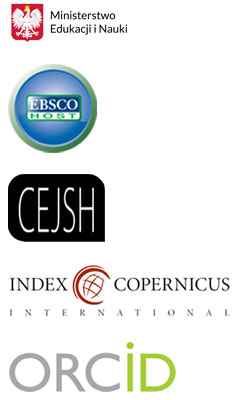Wydanie 2021/2 (tom36) / Issue 2021/2 (vol.36)
Od Redakcji
Przekazujemy Czytelnikom kolejny numer Sztuki Leczenia, a wraz z nim informację o intensywnych staraniach zespołu redakcyjnego o podniesienie pozycji Czasopisma. Ich dotychczasowym efektem stało się między innymi umieszczenie go na ministerialnej liście czasopism punktowanych, znaczące podniesienie punktacji w IC, która obecnie wynosi 88,64 pkt, podobnie jak zmiana wydawnictwa zaplanowana na przyszły rok kalendarzowy. Kolejne numery będą już wydawane przez Wydawnictwo UJ, znane z wysokiej pozycji na rynku wydawniczym książek i czasopism. Starając się o podniesienie punktacji, z żalem rozstajemy się z dotychczasową oficyną wydawniczą Fall, która przez ostatnie lata rzetelnie i z dużym zaangażowaniem wspierała nas w przygotowaniu kolejnych wydań Sztuki Leczenia. Jednocześnie liczymy, że nasze kolejne działania związane ze staraniami dotyczącymi rejestracji czasopisma w kolejnych liczących się zagranicznych bazach również zakończą się sukcesem.
W naszym zamierzeniu obecny numer miał być w całości poświęcony wciąż bardzo aktualnej tematyce pandemii. Prac, na które liczyliśmy, napłynęło stosunkowo niewiele, więc tematyka ta obecna jest tylko w trzech opracowaniach. Być może jest to po części odzwierciedleniem ogólnie mało przewidywalnej sytuacji, w której podejmowanie pilnych i poważnych wyzwań, w tym towarzyszących obecnej pandemii, odbywa się wciąż w warunkach dużej niepewności, sprzecznych i niespójnych informacji utrudniających tworzenie trafnych przewidywań co do przyszłości.
Numer otwierają badania trójki autorów, którymi są: Ieva Stankutė, Mindaugas Stankūnas i Katarzyna Czabanowska. Tytuł pracy to Leadership and crisis management of COVID-19 pandemic in Lithuania – a survey among public health professionals. Zaprezentowane w opracowaniu badania, wykonane w instytucjach zdrowia publicznego na Litwie, zdają się wskazywać, że ich pracownicy oceniają lepiej funkcjonowanie opieki zdrowotnej w trakcie pierwszej fali zachorowań niż podczas kolejnej. Wniosek ten pośrednio wskazuje, że warunki towarzyszące obecnej pandemii oraz jej cechy utrudniają uczenie się oparte na doświadczeniu. Być może chodzi też o rosnące oczekiwania dotyczące zapewnienia poczucia bezpieczeństwa obywatelom.
Kolejna praca ma charakter poglądowy, choć odwołuje się do doświadczeń wyniesionych z praktyki psychologa-psychoterapeuty pracującego online głównie z dziećmi i młodzieżą. Praca ta, autorstwa Mileny Maryon‑Nowak, pt. Psychoterapia dzieci i młodzieży online – nowe wyzwanie w kontekście pandemii Covid-19 / Online psychotherapy of children and adolescents – a new challenge in the context of a pandemic Covid-19 podejmuje stosunkowo nowy i bardzo interesujący wątek, jakim jest rozwój terapii online w odniesieniu do emocjonalnych problemów, z jakimi zmagają się młodzież i dzieci z powodu obecnej pandemii. Jak wskazuje autorka, ważne wydaje się poszukiwanie alternatywnych sposobów prowadzenia terapii w trybie online oraz optymalizowanie tego rodzaju wsparcia.
Następny artykuł dotyczący problematyki SARS-CoV-2 to praca Bogusława Stelcera pt. Covid-19 – pandemia strachu / Covid-19 – the fear of pandemic. Autor zwraca w niej uwagę na element strachu towarzyszący pandemii oraz na konsekwencje współpracy bądź przeciwnie – ostrych podziałów powstających w obliczu poważnego zagrożenia, jakie ona niesie.
Kolejna praca to interesujący artykuł Doroty Kubackiej-Jasieckiej pt. Tatuaż i pirsing – wpływ wzorów kultury czy autoagresja? / Tatooing and piercing – impact of cultural patterns or self-destructive behaviour? Autorka podejmuje w nim złożone zagadnienie motywacji i psychologicznych mechanizmów popularnych i modnych współcześnie form upiększania i modyfikowania wyglądu swego ciała poprzez jego tatuowanie i kolczykowanie.
Następna praca mieszcząca się w obecnym numerze to artykuł dwóch autorów Ryszarda Praszkiera i Michała Wroniszewskiego pt. Autyzm a problem synchronizacji / Autism and Synchronization. Autorzy wskazują w nim na znaczenie i możliwości terapeutycznego wykorzystania zjawiska synchronizacji poprzez specyficzne ćwiczenia odczuwania rytmu przez osoby poddawane leczeniu, a szczególnie dzieci autystyczne.
Ostatnia praca to opracowanie powracające do tematu pandemii, tym razem w ujęciu historycznym. Jest to artykuł Katarzyny Pękackiej-Falkowskiej, pt. Kazanie „Ob man vor dem Sterben fliehen möge” (1527) Marcina Lutra jako podstawa ideologiczna walki z zarazą i etyki obowiązku tempore pestis wśród ewangelików wyznania augsburskiego: uwagi wstępne. To dość hermetyczne, zdawałoby się, opracowanie szczególnie akcentuje dość często sygnalizowany w różnych pracach wątek znaczenia solidarności i jedności ludzi w obliczu niebezpieczeństwa oraz wielkich tragedii i katastrof.
Drugi numer 2021 Sztuki Leczenia zamyka jak zwykle spis recenzentów, którzy recenzowali tegoroczne prace. Wszystkim Im serdecznie dziękujemy.
Na koniec chcielibyśmy życzyć wszystkim naszym Czytelnikom zarówno interesującej lektury prac zamieszczonych w obecnym numerze, jak i pomyślności w nadchodzącym Nowym Roku 2022.
Redakcja Sztuki Leczenia
Joanna Bonior i Marek Motyka
From the Editor
We are providing the Readers with the next issue of Art of Healing and with it the information of intense efforts of the editorial team to raise the status of the Periodical. What they have achieved so far is for example putting it on the ministerial list of scored periodicals, raising the score of the periodical in IC, which is now 88,64 points, as well as a change of the publisher planned for the next calendar year. The next issues then will be published by the Jagiellonian University Publishing House, known for its high position on the publishing market of books and periodicals. Aiming at a higher score, we regret to part with the existing FALL publishing company, which for the last years has been supporting us earnestly and with great commitment in preparing subsequent issues of Art of Healing. At the same time we hope that our next actions connected with efforts concerning registration of the periodical in the next major foreign bases will be successful.
Our intention was to devote the whole present issue to the current subject of the pandemic. We received relatively few texts that we had counted on, so this subject is present only in three articles. Perhaps it is partially a reflection of a generally hardly predictable situation, in which taking up urgent and serious challenges, including those accompanying the present pandemic, is still taking place in the circumstances of great uncertainty, contradictory and incoherent information, making it difficult to make accurate predictions concerning the future.
The issue opens with studies by three authors, who are: Ieva Stankutė, Mindaugas Stankūnas and Katarzyna Czabanowska. The title of the text is Leadership and crisis management of COVID-19 pandemic in Lithuania – a survey among public health professionals. The research presented in the article carried out in the institutions of public health in Lithuania seems to indicate that their employees assess better the functioning of health care during the first wave of COVID-19 than during the next one. This conclusion indirectly reveals that the conditions accompanying the present pandemic and its features make learning based on experience difficult. Perhaps it is also about growing expectations which regard ensuring the sense of security to the citizens.
The next article is of an illustrative character, although it refers to the experience got out of the practice of a psychologist-psychotherapist working online mainly with children and youth. This article written by Milena Maryon‑Nowak, entitled Online psychotherapy of children and adolescents – a new challenge in the context of a pandemic Covid-19, picks up a relatively new and very interesting aspect which is the development of online therapy in reference to emotional problems which adolescents and children struggle with because of the present pandemic. As the author points out, it seems important to search for alternative ways of conducting therapies online and optimizing this kind of support.
Another article referring to the issue of SARS-CoV-2 is the work of Bogusław Stelcer, entitled Covid-19 – the fear of pandemic. The author indicates the element of fear which is accompanying the pandemic and the consequences of cooperation or just the opposite – sharp divisions appearing in the face of the serious danger that it brings.
The next text is an interesting article by Dorota Kubacka-Jasiecka entitled Tattooing and piercing – impact of cultural patterns or self-destructive behaviour? The author picks up the complex issue of motivation and psychological mechanisms of popular and nowadays fashionable forms of beautifying and modification of the appearance of one’s own body by its tattooing and piercing.
Another work included in the present issue is an article by two authors Ryszard Praszkier and Michał Wroniszewski entitled Autism and synchronization. In this article the authors indicate the significance and possibilities of therapeutic application of the phenomenon of synchronization through specific exercises of feeling rhythm by people undergoing treatment, particularly autistic children.
The last article is a text returning to the subject of the pandemic, this time in a historical spin. It is an article written by Katarzyna Pękacka-Falkowska, entitled The sermon ‘Ob man vor dem Sterben fliehen möge’ (1527) by Martin Luther as an ideological basis of the fight against plague and ethics of duty tempore pestis among Augsburg Evangelicals: some introductory remarks. This, as it seems, quite hermetic study particularly emphasizes the thread of importance of solidarity and unity of people in the face of danger and big tragedies and disasters, quite frequently indicated in various articles.
The second issue 2021 of Art of Healing closes as usual with a list of reviewers who have reviewed the articles of this year. We would like to thank all of them.
At the end, we wish all our Readers both an interesting read of the articles included in the present issue and well-being in the approaching New Year 2022.
Editorial Office of Art of Healing
Joanna Bonior and Marek Motyka



